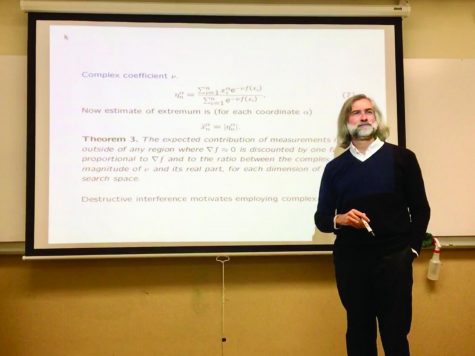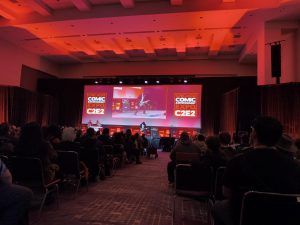Brazilian professor presents a lecture and a new method for optimization, in NEIU
March 26, 2019

Professor Felipe Pait lectured on complex mathematical methods to NEIU students.
A professor from the University of São Paulo traveled thousands of miles and hours to NEIU to discuss mathematics theories with students, staff and other community members. On March 8, University of São Paulo professor, Felipe Pait, gave a presentation titled: “The Barycenter Method for Direct Optimization: An Overview, with Applications to Estimation of Switched Linear Models.”
The event was organized by NEIU’s mathematics department but required help from many people ranging from several departments, including students and faculty members.
In his lecture, Pait showed the properties of his recently developed barycenter method for direct optimization that is used in controlled applications such as in an oil company. “So, the workers of this place are drilling and need to pump for several different wells. They only have a certain capacity for transport, so they need to be careful in pumping. Basically, they have to choose how much oil to pump up from each of the wells. It’s an optimization problem that has practical restrictions,” Pait said.
According to the Brazilian professor, the new method is another way to solve optimization problems. Pait says it depends on the nature of the issues trying to be figured out because which one requires different techniques. “You have to choose which is appropriate. Barycenter method is useful when you don’t really know the mathematics or you don’t really have a well-defined model for your process,” he explained.
The lecture also covered the equivalence of the method’s batch and recursive formulations that can be used to show that it has descent-like properties, despite the fact that no derivatives are used, and that it is robust to noisy measurements and lack of differentiability. The theory even showed how flexible and easy it is to be implemented in mathematics, incorporated with other techniques or not.
The name of the method came up after analogies in mathematics, once it referred to the barycenter or center of mass, although no gravitational physics is involved, as stated by Pait. He says that it is merely an average of the points, “each of them considered as many times over as the mass or weight attributed to the point.”
Regarding the lecture, Pait said it was great once people were interested and engaged. “They had questions and confronted me with other possibilities that maybe I had not thought of, so it was very good. I was presenting here as a working process. It’s something that maybe people can contribute to if they find it interesting or worthwhile.”
Pait was born in São Paulo, Brazil, in 1963 and received a bachelor’s degree in electrical engineering from the University of São Paulo in 1985 as well as a doctorate from Yale University in 1993. In the same year he graduated, he worked in the development of real-time control systems until 1987.
From 2002 to 2004, he was with Alphatech, Inc. in Burlington, Massachusetts, working on the development of algorithms for tracking, sensor fusion and cooperative control. Now, he teaches at Northeastern University of Boston between December and June, and in the University of São Paulo in the other months.









